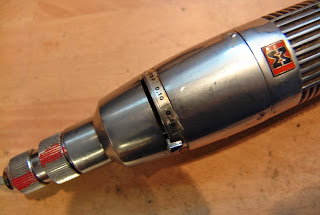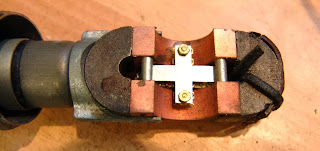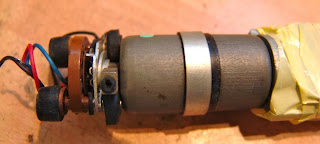Although much much smaller in size than the
Melodium 42B, the RM6 takes some of its design philosophy from its predecessor. The motor assembly has horseshoe magnets above and below the ribbon (like a tiny RCA 44BX), and an inductive filter with multiple cut-off frequencies. It also has an obsolete and hard to find proprietary connector, albeit a different one from the 42B.
The body is made from cast metal which has a tendency to crack, and the first challenge is to get inside the mic without damaging it. There are three tiny metal pins pushed through the mic that fix the grill to the lower body of the mic. These need to be pushed all the way through the mic so that the grill can be removed, and usually these can be found stuck to the magnet, although one will inevitably go missing!
To remove the mic completely, the connector must be unsoldered and the switch tip removed. Once inside, we see something that looks like the Easter Island statues!
The ribbon is hiding behind the baffles, and the motor requires quite a lot of disassembly before the ribbon can be accessed. The ribbon itself is about 1.8 mm wide, so a bit fiddly to fit. Like most mics of a certain age, half the problem is that the ribbon has become oxidised and stiff, and the other half is small particles of wild iron that that have become stuck between the pole pieces, preventing the ribbon from moving freely.
Removing the strong magnets made cleaning and re-ribboning a lot easier! The transformer and filter inductor are housed in a mumetal can, screwed beneath the motor assembly and above the filter switch.
As usual, the mic sounds best without the high pass filter engaged, although I can imagine it being useful to compensate for proximity effect when close micing some instruments.
There doesn't seem to be much information about this mic available on-line, but I have scanned
an old Melodium catalog featuring the RM6. There is also a
French language review of the RM6 over at Audio Fanzine. They seemed to like it, and gave the mic 9 out of 10!

















